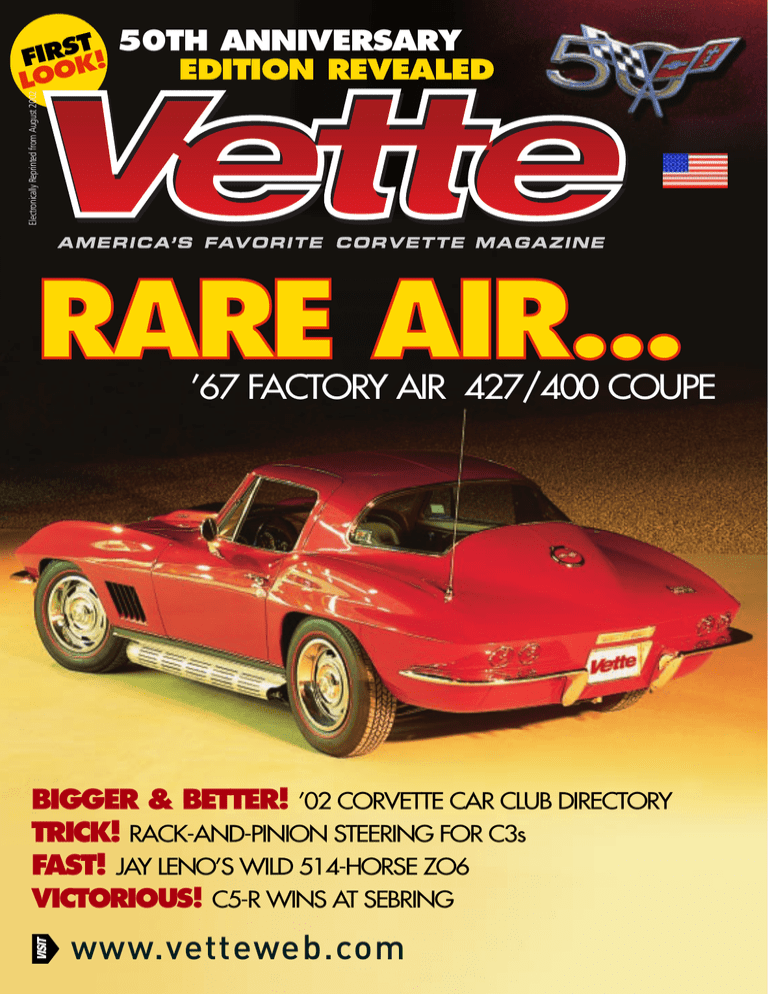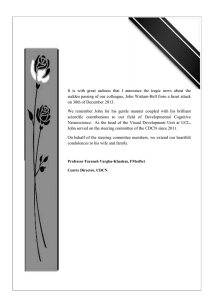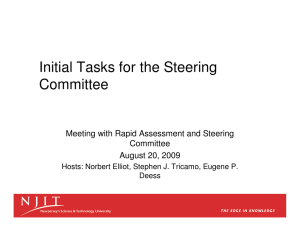
50TH ANNIVERSARY
EDITION REVEALED
Electronically Reprinted from August 2002
T
FIRSK!
LOO
’67 FACTORY AIR 427/400 COUPE
BIGGER & BETTER! ’02 CORVETTE CAR CLUB DIRECTORY
TRICK! RACK-AND-PINION STEERING FOR C3s
FAST! JAY LENO’S WILD 514-HORSE ZO6
VISIT
VICTORIOUS! C5-R WINS AT SEBRING
www.vetteweb.com
TECH
Rack ‘N’ Roll
Installing And
Evaluating The
Steeroids™ Power
Rack-And-Pinion
Steering Conversion
For ‘68-82s
By Bob Wallace and John Nelson
Photography by Bob Wallace
ostalgia is great. Early model
Corvettes, all of ’em, have style
and a certain grace, a sensuousness that isn’t there in a late
model. There’s nothing wrong with a C4 or a
C5’s appearance; their forms are functional, first
and foremost, while their elders were designed
to be eye candy, to be attractive, almost frivolous. But those same glorious shapes cover
mechanical components that, while in many
N
Our subject ’72 Stingray’s
steering system is typical of
the setup used to steer ’6882 Corvettes. Even though
its in pretty good shape for
a collection of 29-year-old
parts, it’s all coming out.
The Steeroids™ kit has
extensive removal instructions, which we’ll only cover
briefly here. Start by breaking the outer tie rod ends
loose, disconnecting the
steering coupler (or “rag”
joint) from the steering column, unbolting the power assist support bracket from the frame rail, disconnecting
the power steering hoses from the pump, and removing two of the three bolts that
hold the steering box to the frame.
instances were advanced compared to much
else that was available in those days of old,
now rank right up there with a Conestoga
wagon.
For the restoration side of the hobby, that’s
part of charm. If you are lucky enough to own
a nice original or correctly restored firstthrough third-gen, you accept the quirks that
were built into the old timers. If your primary
intent is to have a vintage Corvette that can be
driven comfortably and safely, well, them oldies
aren’t always goodies.
Once all that’s
done, you’ll end up
here—at the passenger-side idler
arm. After making
sure someone is
supporting the system, remove the
two bolts holding
the idler arm to the
frame, and the last
bolt securing the
steering box. The
entire system can
then be removed
from the bottom of
the car.
Before going any further, Loy laid out all
the items necessary to mount the new
hardware so that it’d be close at hand.
In a side-by-side comparison, the difference between old and new is striking. The rackand-pinion is no larger then just the lower portion of the old system, sans the steering box
and coupler. Speaking of the steering box, you’ve no doubt noticed that it’s no longer connected to the Pitman arm (arrow). Because Loy McKenrick’s ’72 has tube headers, we
used the appropriate puller to remove the Pitman arm from the steering box. This allowed
us to work it past the headers. Another option would be to remove the driver-side headers.
This shouldn’t be an issue on cars running stock exhaust manifolds.
These two large, rubber split-bushings are
then installed onto the rack-and-pinion
unit. The shape of each one corresponds to
its mounting surface on the new rack, making this a foolproof operation.
The rack-and-pinion is then mounted to the
frame brackets that were previously
installed and torqued to the specified value
(30 ft-lbs, in this case).
▲
Moving to the left side, the new driver-side
bracket bolts in at the same location as the
old steering box. The Steeroids setup also
includes a driver-side gusset, which attaches to the mount for the power assist cylinder (arrow).
The passenger-side bracket for the new set
up bolts in just as the old idler arm did.
Rack ’N’ Roll
The next
step is to
bolt the tie
rod bracket
to the rackand-pinion.
The outer
holes are
positioned
to the top of
the rack.
The U-joints are secured to their respective
shafts with set screws. The steering column
set screw should sit on the flat, machined
surface before its tightened; the other set
screws will need to be aligned with matching holes in the Steeroids™ shafts. Be sure
to use a little thread-locking compound on
the set screws.
At this point, our new rack unit is in place,
and we’re ready to get this baby hooked up.
The Steeroids™ kit includes an assembly
made up of a single U-joint, an intermediate shaft, and a double U-joint. The single
U-joints is removed and installed onto the
steering rack.
The intermediate shaft support bearing can
then be installed onto the remaining part of
the assembly.
Here’s the completed coupler assembly.
Before final tightening everything, the support bearing (arrow) will need to be adjusted to minimize U-joint binding while turning.
As seen here, the double U-joint connects
to the factory steering column, while the
intermediate shaft has been reconnected to
the single U-joint. The support bearing
bolts to the driver-side bracket.
The new power steering hoses can then be
installed on the rack and connected to the
factory power steering pump.
Rack ’N’ Roll
After threading the new tie rod ends onto the supplied tie rod sleeves, the two tie rod assemblies
are bolted to the tie rod bracket and each side’s
steering knuckle. Be sure to tighten both castle
nuts so that new cotter pins can be installed.
With both tie rods in place and only
a few steps left, this is a good point
to admire the day’s work—and to
recheck every nut and bolt to make
sure its been properly torqued.
Coming into the home stretch, Loy used a pair of
adjustable wrenches to set an approximate alignment.
Since Auto Perfections has an alignment rack, the ’72
didn’t have to travel far to get the job done correctly. For
the rest of us, the Steeroids™ instruction sheet outlines a
procedure for setting an approximate alignment.
Fluid is then added to the system to bring the level to the
appropriate mark (“cold,” in
this case)…
…after which the car can be started and a thorough check for leaks made. Everything
was fluid-tight. The only thing left at this point is to get the Vette’s frontend precisely
aligned—and then to enjoy the car’s slop-free rack-and-pinion steering.
Possibly the two biggest deficiencies in the
first three generations are brakes and steering.
The four-wheel drums were scrapped in 1965.
The disc brakes that were used from 1965-82 still
work well, particularly when treated to the common upgrades like stainless steel sleeves.
Systems like SSBC’s Force 10 (see “Gimme A
Brake,” October 2001) bring those setups in the
21st century, and there’s a plethora of quality
bolt-on front disc brake conversions for the solidaxles.
There is, of course, the Paul Newman/Car
Creations approach—extensively reworking both
ends and portions of the center of ’53-72 frames
to adapt complete late C4 front and rear suspensions, brakes, and power rack steering into the
older models. It’s very well engineered, very well
crafted, works incredibly well, and costs a lot
more than many folks can afford to invest in an
old Shark.
Steering upgrades? Well, that’s another matter
entirely. We know of at least one company that
makes a bolt-in front suspension conversion,
with disc brakes and a Mustang-sourced rackand-pinion steering system, a la street rods, for
’53-62 Corvettes. Owners of ’63-82 Vettes who
want something better than the bulky and imprecise factory worm and sector steering box and, if
equipped with power assist, the even bulkier
setup with hoses, slave cylinder, and power ram
dangling below the car, have been pretty much
out of luck.
There’s a seeming ton of moving, “wear”
parts in the old C1-C3 steering systems, and it’s
not at all unusual to have a quarter turn (of the
steering wheel) dead area or slop in the system,
just from wear in the box and related parts. If the
idler arm is shot, a frontend shimmy is common.
Delightful—dead-on-center steering, sloppy and
imprecise, and the front tires and wheels shake
and shimmy like a third-rate exotic dancer.
Just changing a power steering-equipped ’6382 over to a more contemporary, internallyboosted steering box (and getting rid of the
bulky and leaky ram, cylinder, and related parts)
would be a tremendous improvement for a nonresto driver. Jeff Montgomery, the owner/builder
of the silver split-window in the March 2002
issue, did such a swap, and we’re working with
him on creating a how-to.
It would, however, be a quantum leap forward to be able to convert one of these vintage
Vettes to a modern rack-and-pinion steering system, just like in all C4s and C5s, and almost
everything else automotive in this day and age.
Pure and simple, a rack-and-pinion steering system imparts a much more positive feel, is more
compact, weighs less, and has substantially
fewer moving and wear parts. It’s a win-win situation, and there is now a true bolt-in, powerassisted, rack-and-pinion steering conversion kit
for ’68-82 Corvettes. The system or kit, called
Steeroids™, was in development for at least a
year and a half and has just been released for
sale by the manufacturer, SpeedDirect of Santo,
Texas.
The Steeroids™ power rack kit is a true boltin—no holes to drill, no cutting or welding, not
a single permanent change required. It uses the
original power steering pump. The rest is in the
kit—a brand-new steering rack, well-engineered
and crafted mounting brackets that bolt in place
of the steering box and idler arm, all necessary
hardware, new hoses, tie rod ends, and steering
column adapter and extension shaft.
From the time we first heard about
SpeedDirect’s power rack conversion kit, we
were hot to try one. Since the C5 Shark is still
many months away from going back on the
road, and since it’s been nearly two years since
the ’76 had been driven, we opted to use Loy
McKenrick’s ’72 coupe once again as a guinea
pig. That was actually advantageous because, in
spite of headers, a 383 stroker small-block, and a
home-brewed 700-R4 tranny swap, the platform
of the car is still stock. Plus, Loy has been using
the old Vette as a daily driver for most of the past
25 or so years, and knows every nuance of how
it drives. Who could be better for honestly evaluating a new product for an old Corvette than
someone who’s owned and driven the same car
for multiple decades? The crew at Speed Direct
agreed and sent us a kit out of their first production batch.
The Steeroids™ power rack conversion truly
is a bolt-on. From start to finish, we invested
roughly five man-hours of work, using a hoist
and air tools at McKenrick’s shop, Auto
Perfections. This does not include the time
and/or cost of having the frontend re-aligned by
a quality alignment shop, but does include performing a rough, road test alignment before
pulling the ’72 off the hoist. Most important, at
least from the installation standpoint, is that
every single piece fitted where it was supposed
to and as it was supposed to. Before we began
the installation, we weighed the Steeroids™ kit.
After removing the original steering box, all linkages, and the power steering ram and slave
cylinder, we weighed the old system and found
the power rack setup tipped the scales at 12
fewer pounds than the OEM system.
The price of the Steeroids™ power rack-andpinion conversion for Sharks is $1156, FOB
Santo, Texas. Yeah, that sounds like a healthy
chunk of change, but consider the cost of completely refurbishing an original Shark power
steering system. A brand-new, quick-ratio steering box from Flaming River Industries goes for
$459, all by itself. Using the catalogs of one of
the major Corvette mail order companies, we
came up with a parts-only cost of $659.60 to
completely refurbish the steering system (including idler arm, tie rod ends, hoses, etc.) with a
rebuilt steering box, power steering control
valve, and power steering cylinder (the ram).
With all new parts, no “remanufactured” bits or
pieces, the tally was $959.60. Suddenly that
$1156 figure doesn’t sound all that high.
Most telling was Loy McKenrick’s reaction
when we dropped the hoist and I climbed into
the passenger side of “Old Yeller” and
headed out for a test run. “Holy ****, this thing
steers like a new C5!” was one of his first
comments. He later related that the car’s steering
is very precise, feels much more positive than it
ever had with the stock system, seemed to
respond quicker to any steering wheel inputs,
and, at the same time, didn’t feel as heavy as
the original setup.
It’s always a pleasure to test a new
product that lives up to the hype, and the
Steeroids™ power rack kit for C3s easily lives
up to, if not exceeds, the promise and the hype.
It’s a great addition to any non-resto,
regularly driven third-gen, and a great way to
have the best of nostalgia and a great driver at
the same time.
S O U R C E S
SPEEDDIRECT
1901 S. FM 129, Dept. VM
Santo, TX 76472
(888) 253-9680
www.speeddirect.com
AUTO PERFECTIONS
950 E. Whittier Blvd., Dept. VM
La Habra, CA 90631
(562) 694-3204
Posted with permission from the August 2002 issue of Vette ®
Copyright 2002, PRIMEDIA Inc. All rights reserved.
For more information about reprints from Vette, contact Wright’s Reprints at 877-652-5295



